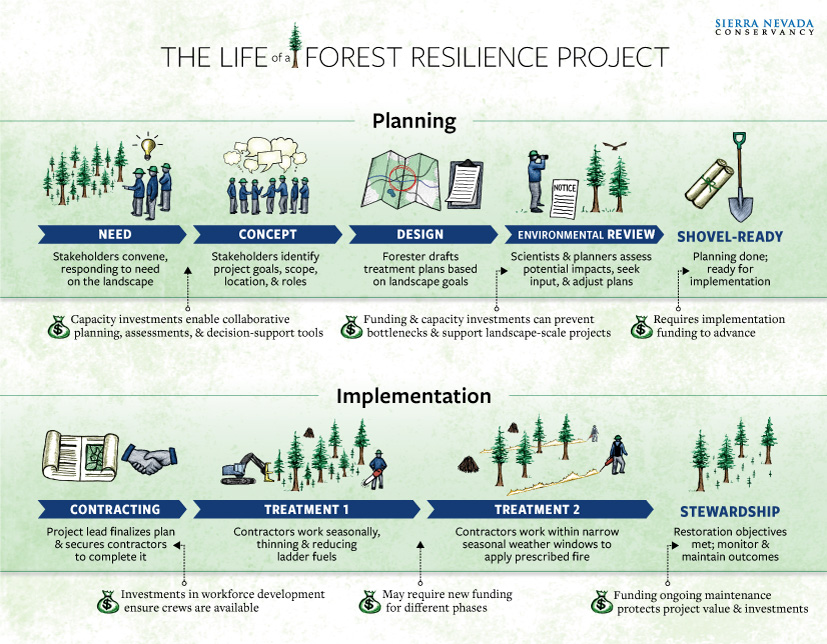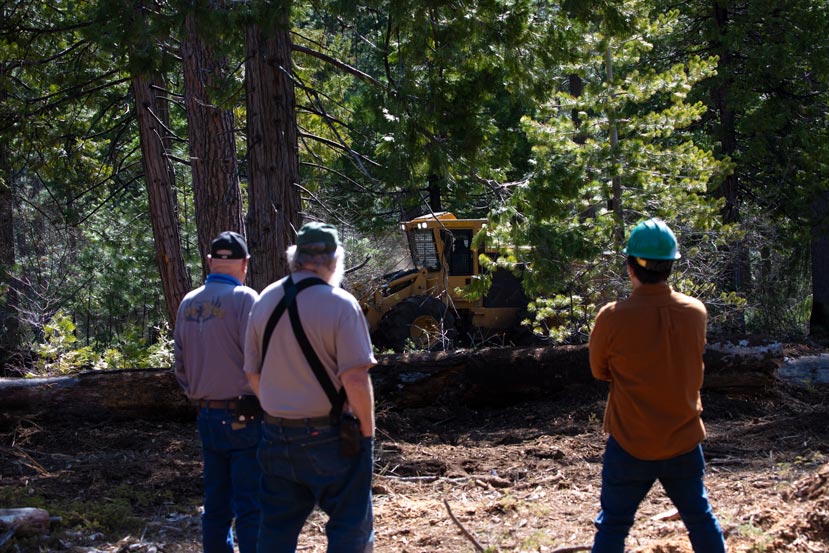Forest restoration and wildfire risk reduction projects are complex, involving many steps and moving parts that determine whether a project will succeed and how long it will take. In the infographic below, we take a look under the hood of forest restoration projects to understand each of the steps necessary to get a project on the ground and through completion.
While the complexity of each project varies, most projects move through the same key steps in the planning and the implementation phases. Consistent funding committed to each step supports the development of a robust project pipeline and the workforce needed to get projects done. This is the pathway to achieving California’s forest restoration and wildfire resilience goals.

A multi-year process
From start to finish, forest restoration and wildfire projects can take anywhere from two to ten years, depending on their size and complexity. Planning alone is often a multi-year endeavor, especially when collaborative partners are engaged in social processes that are difficult to rush, such as establishing relationships with one another, finding common ground among their goals, and building organizational capacity.
More established collaborative groups are increasingly prepared to take on ambitious projects, such as landscape-scale programs of work that would be implemented over the course of five to ten years. Developing a landscape-scale program of work requires trust among diverse stakeholders, sophisticated scientific assessment, and careful environmental review, all of which take time.
A common source of delay occurs when funding cycles and field seasons are out of sync. Grant funding can fluctuate and is often targeted only to project implementation. At the same time, certain steps, such as monitoring for nesting birds during environmental review or applying prescribed fire as a final treatment, can be done only during specific seasons or unpredictable weather windows. As a result, project proponents must often wait for the next funding allocation to advance their project to the next phase, and then wait again for the next fieldwork season.
Add in factors like workforce shortages, fuel cost increases, and extreme wildfire events of the past few years, and it’s easy to understand why projects take time.
Costs at every stage
While we tend to focus on the price tag for implementation, there are costs at every stage in the life of a project. Labor is a significant part of the equation: collaboration and capacity building take considerable staff time; project development and environmental review require expertise from registered professional foresters, scientists, and planners; and project implementation relies on forestry crews. But other costs can also be significant, including the decision-support tools that enable project proponents to identify high-impact and high-priority projects, the machinery that forestry crews use, and the removal and transportation of thinned shrubs, branches, and trees.
In the current funding model, project leads often need to identify and secure a new funding source at each stage of a project’s life cycle. This approach creates inefficiencies that increase administrative costs and encourages proponents to take a piecemeal approach to landscape-scale projects. Low-hanging fruit gets planned and implemented, but some of the highest-impact projects are harder to advance.

Recipe for success
In contrast, consistent funding for every stage helps projects advance more quickly and builds a robust project pipeline. Stable funding also supports critical up-front investments in organizational capacity; the linchpins of the workforce, like foresters, planners, and forestry crew members; and the transportation and utilization infrastructure needed to manage the woody byproducts of restoration.
Disrupting the boom-and-bust cycle in favor of consistent funding can help ensure that the Sierra Nevada Region—and all of California—increase the pace and scale of their work and achieve forest health and wildfire resilience.

